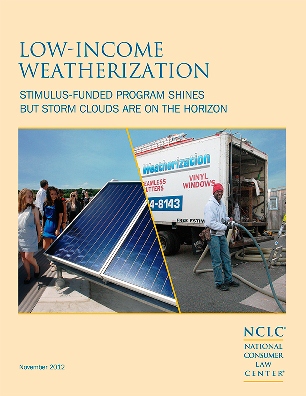Stimulus-Funded Program Shines but Storm Clouds are on the Horizon
In 2009, as part of the Stimulus bill passed in response to the Great Recession, the U.S. government appropriated $5 billion for the federal Weatherization Assistance Program (WAP) to weatherize low-income homes in 50 states over 3 years. States delivered energy improvements to 775,000 homes nationwide, exceeding expectations. Despite this success, federal funding for WAP has been slashed by 66%, threatening this cost-effective program.
Download the full report (PDF)
Download the executive summary (PDF)
Download the charts (PDF)
Download the press release (PDF)
Videos
Green jobs for Colorado veterans
Solar hot water for MA elders in public housing
Web only! Why Congress should boost funding for the Weatherization Assistance Program by Steve Cowell, CEO of Conservation Services Group
Related Publication: Guide to the Rights of Utility Consumers
Beginning April 1, 2013, states would receive, on average, just $1.3 million, barely enough to weatherize a few hundred homes. This drastic cut will decimate the long-standing Weatherization Assistance Program (initiated in 1977) and some states will likely shutter the program. The Stimulus gave WAP a strong boost but much more needs to be done. 80% of eligible homes have not been weatherized.
Consistent and adequate funding of at least $300 million per year is essential if WAP is to carry out its mission of reducing energy bills for those with the least means. An adequately funded WAP would also help all households by fostering the market for high-quality weatherization materials and equipment, and skilled workers.
Quick Facts
![]() Initial Weatherization Goal under the Stimulus: 593,000 homes
Initial Weatherization Goal under the Stimulus: 593,000 homes
![]() Total Homes Weatherized under the Stimulus: 775,000 homes
Total Homes Weatherized under the Stimulus: 775,000 homes
![]() Average annual amount a low-income homeowner saves after home is weatherized: $437
Average annual amount a low-income homeowner saves after home is weatherized: $437
![]() Number of “green” jobs created at peak production through the Weatherization Assistance
Number of “green” jobs created at peak production through the Weatherization Assistance
![]() Program: 14,400 jobs
Program: 14,400 jobs
![]() Estimated percentage of eligible low-income homes weatherized through the Weatherization
Estimated percentage of eligible low-income homes weatherized through the Weatherization
![]() Assistance Program: 20%
Assistance Program: 20%
![]() Weatherization Assistance Program budget for FY2013: $68 million, which is a 95% cut
Weatherization Assistance Program budget for FY2013: $68 million, which is a 95% cut
![]() from the annual spending level under the Stimulus and a66% cut from the pre-Stimulus level
from the annual spending level under the Stimulus and a66% cut from the pre-Stimulus level
Key Findings & Recommendations
1. Consistent federal funding for the Weatherization Assistance Program is essential. When funding soars up and then crashes down, it is extremely difficult to attract and retain adequate numbers of contractors who will deliver high-quality services to low-income clients. What’s needed to adequately maintain the program? At least $300 million per year.
2. State weatherization offices must provide adequate training, support, and oversight to ensure high-quality programs. The Weatherization Assistance Program is a residential rehab program that requires solid energy assessments, adequate training for weatherization workers, skilled contractors, and qualified post-installation inspections. Each state must provide the training and support needed to carry out these functions well.
3. Weatherization funds can help test the value of new technologies in a controlled environment. Under the Stimulus, the Department of Energy allocated $90 million to install renewable energy and energy efficiency technologies that normally could not be installed due to higher costs or other limitations. Investing in such pilot programs expands benefits to low-income households, and the data derived from actual installations can drive further innovation.
4. Weatherization is an all-around winner. Low-income households have an easier time paying their energy bills and live in healthier homes. The local economy receives a boost through the creation of jobs. Small businesses benefit. And, greenhouse gas emissions and pollution are reduced.

